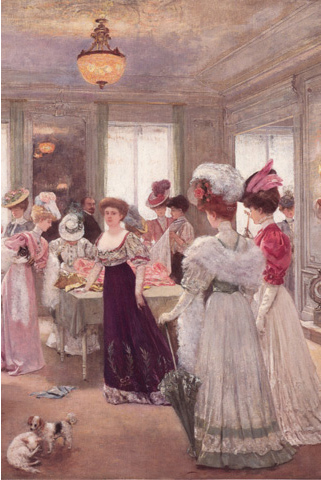Rosalind Williams, Dream Worlds
The Changing Nature of Consumption in Paris
The advent of the consumer revolution in the French provinces was more gradual than in the cities but was still decisive. In the 1860s there were still large regional differences in provincial consumer habits: in Provence a peasant ate wheat bread; in the north he ate potatoes and rye bread; and in the center of the country, he ate chestnuts and potatoes. By 1900, they all ate wheat bread. In the 1860s the dress of peasant and also of working-class women was noticeably darker and cruder than the complicated trains, trailing skirts, laces, and ribbons of wealthier women. By the 1890s everyone wore shorter, simpler, more colorful clothes. Mass consumption means that similar merchandise reaches to all regions and all classes, and by the turn of the century this uniform market was expanding in France.
The consumer revolution introduced a style of consumption unlike the model that had originated in the courts and had gradually spread among the wealthy bourgeoisie. The upper classes had assumed that the kind of luxuries they preferred would permeate the lower levels of society in time. The future was expected to bring, in the popular phrase, "the democratization of luxury." The future held a rude surprise. The luxury that was democratized was quite different in character from the upper-class paradigm. And in creating this new style of mass consumption the French were nearly as preeminent in the nineteenth century as they had been in developing the courtly model in earlier times. France pioneered in retailing and advertising, the twin pillars of modern consumer life. Its capital city became a sort of pilot plant of mass consumption. The period of its most rapid change was just beginning when Denise Baudu is supposed to have disembarked there. By the time she reached middle age, a quarter of a century later, she would have seen the transmutation of Paris from the cramped city of Victor Hugo to a modern capital of consumption, a city of boulevards, cafes, electric lights, apartments, advertising posters, the Metro, cinemas, restaurants, and parks, with production largely exiled to an outer belt while the heart of the city was devoted to commerce. If the North of England is the landscape that symbolizes the industrial revolution, the Ile de France [the area around Paris]can well claim to serve as the emblem of the consumer revolution.
French initiative in creating the new style of mass consumption was crowned by the Paris expositions of 1889 and 1900. There was revealed for the first time a planned environment of mass consumption; there thoughtful observers realized, in a confused and uneasy way, that they were immersed in a strange new world of consumer behavior. They saw crowds milling around displays of luxurious automobiles and around glass cages displaying couturier-clothed mannequins; taking imaginary voyages via cinematic techniques to the floor of the sea or the craters of the moon; and, at night, staring at displays of lighted fountains or at voluptuous belly dancers wriggling in a reproduction of a Cairo nightspot. The expositions and similar environments (such as department stores and automobile trade shows) displayed a novel and crucial juxtaposition of imagination and merchandise, of dreams and commerce, of collective consciousness and economic fact. In mass consumption the needs of the imagination play as large a role as those of the body. Both are exploited by commerce, which appeals to consumers by inviting them into a fantasy world of pleasure, comfort, and amusement.
